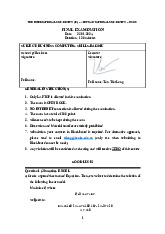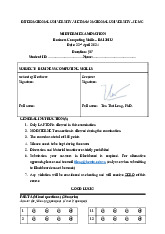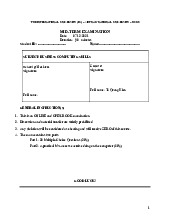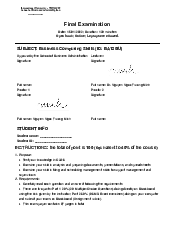



Preview text:
Chapter 1:
1-1 How are information systems transforming business, and why are they so essential for
running and managing a business today?
• Describe how information systems have changed the way businesses operate and their products and services.
• Identify three major new information system trends.
• Describe the characteristics of a digital firm.
• Describe the challenges and opportunities of globalization in a “flattened” world.
• List and describe six reasons why information systems are so important for business today.
1-2 What is an information system? How does it work? What are i ts management,
organization, and technology components? Why are complementary assets essential for
ensuring that information systems provide genuine value for organizations?
• Define an information system and describe the activities it performs.
• List and describe the organizational, management, and technology dimensions of information systems.
• Distinguish between data and information and between information systems literacy and computer literacy.
• Explain how the Internet and the World Wide Web are related to the other technology
components of information systems.
• Define complementary assets and describe their relationship to information technology .
• Describe the complementary social, managerial, and organizational assets required to optimize
returns from information technology investments.
Case Study: Did Information Systems Cause Deutsche Bank to Stumble?
1. Identify the problem described in this case study. What management, organization, and
technology factors contributed to this problem?
2. What was the role of information technology at Deutsche Bank? How was IT related to the
bank’s operational efficiency, decision-making capability, and business strategy?
3. Was Deutsche Bank using technology effectively to pursue its business strategy? Explain your answer.
4. What solution for Deutsche Bank was proposed? How effective do you think it will be? Explain your answer Chapter 2:
2-1 What are business processes? How are they related to information systems?
• Define business processes and describe the role they play in organizations.
• Describe the relationship between information systems and business processes
2-2 How do systems serve the different management groups in a business, and how do
systems that link the enterprise improve organizational performance?
• Describe the characteristics of transaction processing systems (TPS) and the roles they play in a business.
• Describe the characteristics of management information systems (MIS) and explain how MIS differ from TPS and from DSS.
• Describe the characteristics of decisionsupport systems (DSS) and how they benefit businesses.
• Describe the characteristics of executive support systems (ESS) and explain how these systems differ from DSS.
• Explain how enterprise applications improve organizational performance.
• Define enterprise systems, supply chain management systems, customer relationship
management systems, and knowledge management systems and describe their business benefits.
• Explain how intranets and extranets help firms integrate information and business processes
2-3 Why are systems for collaboration and social business so important, and what technologies do they use?
• Define collaboration and social business and explain why they have become so important in business today.
• List and describe the business benefits of collaboration and social business.
• Describe a supportive organizational culture and business processes for collaboration.
• List and describe the various types of collaboration and social business tools.
Case Study: Should Companies Embrace Social Business?
1. Identify the management, organization, and technology factors affecting adoption of internal corporate social networks.
2. Compare the experiences implementing internal social networks of the organizations described
in this case. Why were some successful? What role did management play in this process?
3. Should all companies implement internal enterprise social networks? Why or why not? Chapter 3:
3-1 Which features of organizations do managers need to know about to build and use
information systems successfully?
• Define an organization and compare the technical definition of organizations with the behavioral definition.
• Identify and describe the features of organizations that help explain differences in
organizations’ use of information systems
3-2 What is the impact of information systems on organizations?
• Describe the major economic theories that help explain how information systems affect organizations.
• Describe the major behavioral theories that help explain how information systems affect organization
• Explain why there is considerable organizational resistance to the introduction of information systems.
• Describe the impact of the Internet and disruptive technologies on organizations.
3-3 How do Porter’s competitive forces model, the value chain model, synergies, core
competencies, and network economics help companies develop competitive strategies using information systems?
• Define Porter’s competitive forces model and explain how it works.
• Describe what the competitive forces model explains about competitive advantage.
• List and describe four competitive strategies enabled by information systems that firms can pursue.
• Describe how information systems can support each of these competitive strategies and give examples.
• Explain why aligning IT with business objectives is essential for strategic use of systems.
• Define and describe the value chain model. • Explain how the value chain model can be used to
identify opportunities for information systems.
• Define the value web and show how it is related to the value chain.
• Explain how the value web helps businesses identify opportunities for strategic information systems.
• Describe how the Internet has changed competitive forces and competitive advantage.
• Explain how information systems promote synergies and core competencies.
• Describe how promoting synergies and core competencies enhances competitive advantage.
• Explain how businesses benefit by using network economics and ecosystems.
• Define and describe a virtual company and the benefits of pursuing a virtual company strategy
Case Study: Grocery Wars
1. Analyze Amazon.com and Walmart using the value chain and competitive forces models.
2. Compare the role of grocery sales in Amazon and Walmart’s business strategies.
3. What role does information technology play in these strategies?
4. Which company is more likely to dominate grocery retailing? Explain your answer Chapter 4:
4-2 What specific principles for conduct can be used to guide ethical decisions?
• List and describe the five steps in an ethical analysis.
• Identify and describe six ethical principles
Case Study: Facebook Privacy: Your Life for Sale
1. Perform an ethical analysis of Facebook. What is the ethical dilemma presented by this case?
2. What is the relationship of privacy to Facebook’s business model?
3. Describe the weaknesses of Facebook’s privacy policies and features. What management,
organization, and technology factors have contributed to those weaknesses?
4. Will Facebook be able to have a successful business model without invading privacy? Explain
your answer. Could Facebook take any measures to make this possible?




